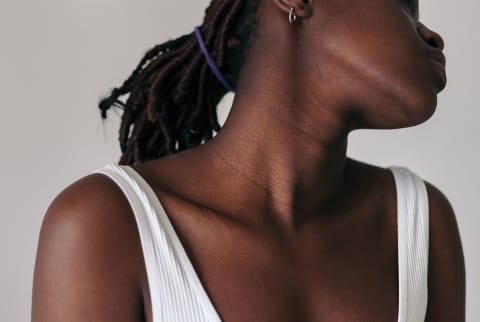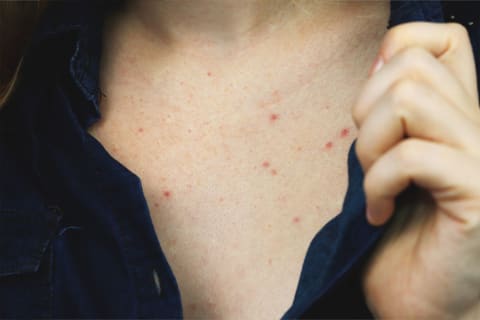While body acne may be easier to hide at times, it can still cause deeply rooted insecurity and frustration. Plus, knowing how to treat acne on parts of the body, like the chest isn’t always as openly discussed. To help you out, we asked derms for the 101 on chest acne from causes to treatments and more. Let’s dive in. “However, as compared to facial acne, there are a few things that set it apart, primarily the fact that chest and back acne can more easily be aggravated by excessive sweating and heat because clothing can further occlude the skin and contribute to irritation and friction,” Fenton adds. What’s more, both facial and chest acne can be linked to hormonal imbalances. “Having too much androgens, or male hormones, in a woman can trigger body acne,” Fenton explains. “Most frequently, this occurs in men during puberty and affects women during the phases of their menstrual cycle, pregnancy, and menopause,” board-certified dermatologist Kim Nichols, M.D., FAAD, tells mbg. This form of hormonal acne is also more common for women than men. “Very rarely would chest acne be indicative of a hormonal problem in a male (unless they were taking some sort of supplement or anabolic steroids),” Fenton notes. In this 2014 study1, researchers found that using salicylic acid directly impacts sebum production. This is essential for those with oily and acne-prone skin, as sebum can clog the pores and trigger breakouts. Because salicylic acid is a multitasking ingredient, it treats acne in many ways, from exfoliating to managing bacteria and regulating sebum production. It’s no wonder clinical studies deem this ingredient a safe and effective treatment for breakouts2. You can opt for a salicylic acid face cleanser, body wash, or use a leave-on treatment like the Paula’s Choice Acne Body Spray. This product is easier to use for areas like the chest and back, as the spray mechanism covers a greater area than a traditional face serum. If you do opt for a wash-off product, be sure to leave it on the skin for 30 seconds to a minute before rinsing it off so you can give the salicylic acid time to work its magic. That means the acid can be helpful for both inflammatory acne (your angry pustules, cysts, and pimples) as well as comedonal acne (blackheads and whiteheads). The best way to use benzoyl peroxide is in a wash-off formula rather than a leave-on serum. Need a suggestion? The INKEY List SuperSolutions 5% Benzoyl Peroxide Cleanser is one A+ (and budget-friendly) option. The reason you’ll want to opt for a wash is because benzoyl peroxide can dry out the skin. To mitigate this, be sure to follow up your shower with a hydrating, noncomedogenic body lotion. More on this in a bit. As with all retinoids, you should be mindful of potential dryness and irritation. Luckily, adapalene is relatively gentle compared to its prescription-grade cousins. Start by using adapalene on your chest every two or three days to allow your skin the proper adjustment period before bumping it up to every other day or even daily use. This may seem like a powerful treatment to use so often, but the skin on your chest tends to be more tolerant than the skin on the face. “Generally in my experience, most people can tolerate stronger treatments on the chest than they can on the face (particularly the cheeks, which get more dry than the T Zone),” Fenton says. “The reason for this is because the skin on the chest often produces a more consistent amount of moisture, as opposed to the face that tends to have oily areas (like the nose and forehead) and at the same time can have dry areas (like the cheeks), so it can be more difficult to find the right balance on the face,” he adds. “The face is also always exposed to the elements, particularly during the winter this can contribute to more dry and irritated skin,” he says. However, each individual is different, so lay off the daily retinoid use if your skin begins to get irritated. This doesn’t mean you should lay off body lotion altogether, though. In fact, you’ll need a hydrating layer to maintain healthy skin and work on clearing acne, especially if you do incorporate salicylic acid, benzoyl peroxide, or adapalene into your routine. The fix? Just run the full ingredient list (which can usually be found online) through this pore-clogging ingredients checker from Acne Clinic NYC to be sure. In addition, how often you clock a full eight hours of sleep and what you consume food-wise matters too. See, there’s a whole host of factors that go into hormonal balance; sleep and diet are included. If you want to dive into the connection between diet and acne, you can read all about it here. And if you want to learn more about how your sleep affects your skin, we have a breakdown for that too. In both men and women, buildup of sweat, dead skin, and bacteria can cause chest acne. Hormones, however, don’t tend to trigger chest acne in males as often. “Very rarely would chest acne be indicative of a hormonal problem in a male (unless they were taking some sort of supplement or anabolic steroids),” Fenton notes.




